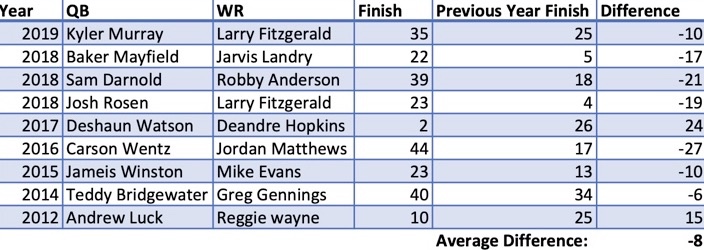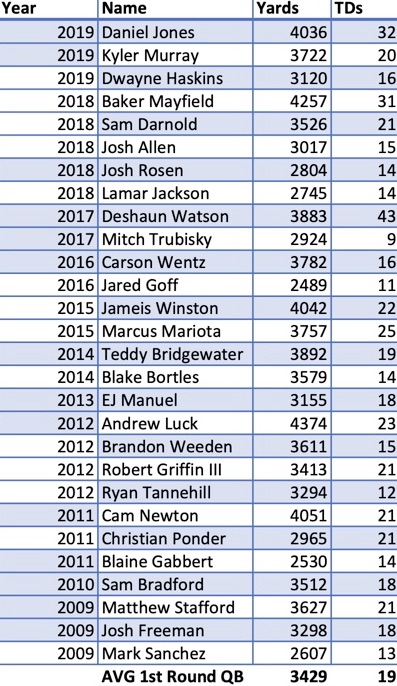Every year, rookie quarterbacks supplant old veterans via the NFL Draft. In fantasy football, we rarely account for the consequences their growing pains might have on the receivers in their offenses. In 2020, the Bengals, Dolphins, and Chargers drafted a quarterback in the first six picks. Today, we use PlayerProfiler’s advanced stats and metrics to determine what to expect from these offenses in 2020.
Historical Data
Since 2011, the average finish for a rookie quarterback’s top receiver was No. 39 in Fantasy Points Per Game. This number is adjusted for only the games played by the rookie quarterback. For example, Courtland Sutton‘s production with Drew Lock at quarterback only accounts for the five games that Lock started. With Lock, Sutton was the WR27 in points per game with only one Top 24 finish. In the games without Lock, Sutton was the WR19 with six top 24 finishes in 11 games. A similar story is told when zooming in on Washington. With Dwayne Haskins, Terry McLaurin was the WR29 in points per game with two top 24 finishes in that seven game span. In the seven games prior to Haskins’ start, McLaurin was the WR19 in points per game with four Top 24 finishes. It’s clear there’s a trend here.
What About Stud Wide Receivers?
Terry McLaurin and Courtland Sutton were unproven prior to last season. Below is a chart showing the difference in Fantasy Points per Game between receivers with rookie quarterbacks and their finish the year prior.
Of the quarterbacks with receivers that finished in the top 36 the year prior, the average change from year to year was minus eight. Last year, this was the difference between Amari Cooper and John Brown. When looking at the numbers broadly, it’s clear that a rookie quarterback is not usually fantasy friendly. Of the nine receivers who qualified, seven regressed in their season with a rookie quarterback. At first glance, DeAndre Hopkins stands out as an outlier, being WR26 the previous year and then rising to a WR2 level with Deshaun Watson. This can be rationalized due to having Tom Savage and Brock Osweiler at quarterback the year prior. In 2015, two years before drafting Watson, Hopkins finished as the WR4 in Fantasy Points per Game. While Watson maintained Hopkins’ value, it’d be a stretch to say he propelled him 24 spots in the wide receiver rankings in 2017.
It’s important to note Larry Fitzgerald‘s and Mike Evans‘ production with rookie quarterbacks. These are both receivers we know are good. Fitzgerald is an all time great and regressed from WR4 to WR23 with Josh Rosen. While people may point to Rosen’s lack of skill in hindsight, it only shows how unpredictable rookie quarterbacks can be. However, we know Jameis Winston is good for fantasy due to his gunslinging mentality. Despite this, Evans regressed from WR13 as a rookie to WR23 with Winston under center.
What Does This Mean For 2020?
Last April, three quarterbacks were drafted with real opportunity to start in year one. These quarterbacks are Joe Burrow, Tua Tagovailoa, and Justin Herbert. It’s worth noting the Packers traded up for Jordan Love in the first round, but the consensus is that he won’t be starting until 2021, assuming Aaron Rodgers stays healthy. With Burrow, Tagovailoa, and Herbert set to shake things up in their respective offenses, it’s time to adjust our expectations for their fantasy counterparts. Quarterbacks drafted in the first round since 2009 average 3,429 yards and 19 touchdowns over a 16-game span.
In 2019, this would have been good for No. 25 and No. 27, respectively. Typically, a bottom-third passing offense doesn’t bode well for the receivers involved.
Joe Burrow – Bengals
To get a feel for the new-look Bengals offense we have to look at Joe Burrow from an unbiased perspective. On DraftKings Sportsbook, his over/under totals are set at 3,700 yards and 21 touchdowns. While this is on the lower side in terms of passing production, Burrow will make a great fantasy asset due to his rushing floor. In two years as LSU’s starter, he rushed for 767 yards and 12 touchdowns. It’s his receivers we should be concerned about. Currently, A.J. Green and Tyler Boyd are being drafted adjacent to each other at WR30 and WR31 according to FantasyPros’ Consensus ADP. As mentioned before, rookie quarterbacks struggle to support one top-36 wide receiver, nevermind two.
A.J. Green & Tyler Boyd
A.J. Green enters his age-32 season in 2020 and won’t be getting any younger. It isn’t difficult to see a scenario where someone whose Best Comparable Player is Alshon Jeffery completely falls off a cliff this year. This is common among tall, physical receivers such as Andre Johnson, Dez Bryant, and Demaryius Thomas. Green already showed a hint of decline when he stumbled from a 29.2-percent (No. 3 among qualified wide receivers) Target Share in 2017 to a 23.5-percent (No. 18) mark in 2018. This number should only decrease with the emergence of Boyd and John Ross, lack of rapport with Burrow, and addition of Tee Higgins via the draft. Green projects to be a low-upside flex option with a massive injury risk.
Check out A.J. Green’s 2020 Projection on PlayerProfiler’s “World Famous” Draft Kit:
Tyler Boyd will also be hindered by the newfound target competition in Cincinatti. In 2019, Boyd drew 147 (No. 7) targets, yet only averaged 13.9 (No. 27) Fantasy Points per Game. The Bengals fed him and he was a weekly flex option at best. It’s hard to imagine him seeing more volume given the new additions. Boyd is a non-sexy, mid-round option, and for good reason. It’s hard to imagine him exceeding last year’s production given that Joe Burrow should throw for somewhere around 3,700 yards and 21 touchdowns while the Bengals threw for 3,994 and 18 touchdowns the year prior. The passing offenses will be similar, yet he will see significantly less volume. Green and Boyd are both fades at ADP. In the middle-to-late rounds it’s smarter to draft for league-winning upside. Deebo Samuel and Marquise Brown are much better options at ADP.
Tua Tagovailoa – Dolphins
Given Tua Tagovailoa‘s injury risk, we can conservatively project Ryan Fitzpatrick to start the first half of the season. In seasonal leagues, we have to put a premium on the first half of the season because it’s important to start strong to make the playoffs. With new addition Chan Gailey, Fitzpatrick will be operating in a familiar system due to their five seasons spent together in numerous locations. With Fitzpatrick as the starter, DeVante Parker is set to smash in 2020.
DeVante Parker
After averaging 15.4 (No. 14) Fantasy points per Game last season, DeVante Parker is currently being drafted as the WR25 on average. At this price, grabbing him is robbery. Ryan Fitzpatrick will continue to throw the football without much care and Parker will dominate again in 2020.
https://www.youtube.com/watch?v=cJreObl1ZCs
In fantasy, we have to pay attention to what teams tell us. Despite having four picks in the top 50 of a loaded wide receiver draft, Miami’s only addition to the receiver room this offseason was seventh-round pick Malcolm Perry. Parker will have to compete with a healthy Preston Williams and Mike Gesicki for targets, but his talent has become undeniable. Any regression caused by Tua Tagovailoa in the back end of the season is already baked into his cost. Parker is a safe, high-end WR3 with top 15 upside.
Justin Herbert – Chargers
In Los Angeles, Justin Herbert was drafted for the future with veteran Tyrod Taylor serving as the win-now bridge quarterback. Of the last seven quarterbacks drafted in the first round, six were starters by Week 4. It’s worth noting that Taylor was supplanted by Baker Mayfield in Week 4 of 2018. It’s easy to see a scenario where Herbert starts no later than Week 6. Thankfully, the Chargers situation is easy to project given the similarities between Herbert and Taylor. They’re both mobile quarterbacks projected to produce similar numbers. Since 2009 ,the average first round rookie quarterback has produced 3,429 yards and 19 touchdowns, while Taylor posted 3,226 yards and 19 touchdowns on average over his three seasons as a starter in Buffalo.
It’s easy to see the passing offense taking a step back in 2020 with Philip Rivers throwing for 4,615 yards and 23 touchdowns last season. In addition to regression in passing efficiency, the Chargers are due for a step back in volume as well. According to Warren Sharp’s Strength of Schedule, the Charger’s have the No. 5 easiest schedule in 2020.
Keenan Allen & Austin Ekeler
The combination of friendly game scripts and run-first quarterbacks will hinder the passing volume in Los Angeles considerably, making it a lock that Keenan Allen doesn’t repeat as a top 10 receiver this season. In 2019, Allen earned 150 (No. 5) targets despite a 26.0-percent (No. 9) Target Share. This massive amount of volume was a result of game script and overall passing volume rather than pure skill. In 2020, it’s hard to project similar numbers. Tyrod Taylor has never targeted a receiver more than 96 times and Allen will struggle to build a rapport with Justin Herbert midseason. Coming off the board as WR18 in PPR leagues, he’s at a discount after finishing as the WR8 last season. Despite this, he’s an easy fade due to the new faces in his quarterback room limiting his upside and weekly floor.
https://www.youtube.com/watch?v=hr1-fUnL464
After drawing 108 (No. 2) targets last year, Austin Ekeler is due for major regression in both volume and efficiency. With two mobile quarterbacks at the helm, look for the Los Angeles running backs to be targeted less. In 2019, the top five rushing quarterbacks targeted their backs on 15-percent of their passes. Given L.A.’s 29-percent rate last season, this is extremely concerning for Ekeler in 2020. Fantasy gamers may rationalize this away with Ekeler being line for Melvin Gordon‘s 55 vacated targets and 162 vacated carries, but this would be a bold claim. Justin Jackson only logged 11 targets last season and the team added a between-the-tackles back in Joshua Kelley to their running back corps. Don’t expect Ekeler to become a bellcow at 5-9 and 199-pounds in 2020. Going off the board at RB11, he’s a fade at ADP due to his limited upside and volume.




